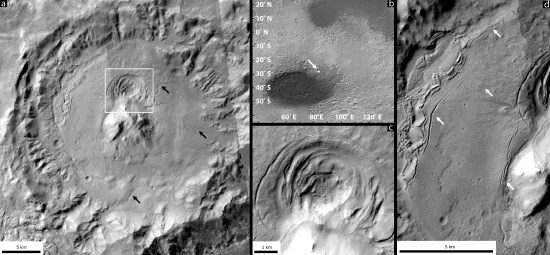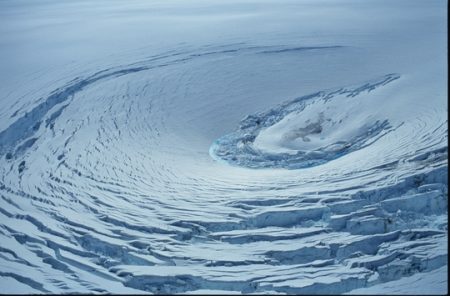November 12, 2016 – A surface depression on Mars has University of Texas researchers hypothesizing about the potential to find life on the Red Planet. Believed to have been formed by volcanic activity beneath a glacier, the depression exists inside a crater on the edge of the Hellas Basin and is surrounded by ancient glacial deposits. As seen from the Mars Reconnaissance Orbiter it appears to be a dramatic dip in elevation 550 meters (1,800 feet) below its surface surroundings.
States Joseph Levy, University of Texas Institute for Geophysics, “We were drawn to this site because it looked like it could host some of the key ingredients for habitability — water, heat and nutrients.” The depression first photographed by Mars Reconnaissance Orbiter bears a resemblance to a geomorphological feature found here on Earth known as ice cauldrons. They can be seen on Greenland and Iceland. These are geothermally formed depressions caused when volcanoes erupt under ice causing melting and subsequently the subsiding of the land at the eruption site. In some instances Iceland ice cauldrons can measure as much as 1 kilometer (0.6 miles) in diameter. Seen below, the Hellas Basin ice cauldron lies just above the central peak of the crater in the picture on the left. It is much larger than ice cauldrons typically seen here on Earth.

Liquid water plays a significant role in ice cauldrons on our planet and researchers speculate that it plays a similar role on Mars. And where there is water there is the chance for habitability. The potential for life is enhanced by the fact that volcanism would provide local heating to the site.
The research appears in a paper entitled, “Candidate volcanic and impact-induced ice depressions on Mars” appearing in the November issue of Icarus, the International Journal of Solar System Studies.
What the ice cauldron in Hellas Basin may have looked like at the time of formation can be seen in an ice cauldron image from Iceland’s Vatnajokull ice cap seen below. It probably would have been created during a past Martian glacial period in the planet’s history.








